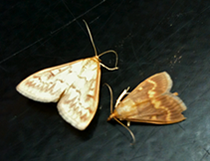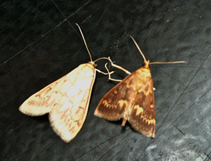Evolution and Speciation of the European Corn Borer - A CodonCode Aligner User Showcase

for future DNA work

This CodonCode Aligner user showcase shows how CodonCode Aligner is used to study different aspects of evolution, speciation and mutation of the European Corn Borer. At the Dopman Laboratory at Tufts, PhD student Crista Burke researches the post-diapause development time (PDD) of the European Corn Borer with the primary aim to link PDD with its genetic locus, and to understand PDD’s implications as a barrier to gene flow.
Crista uses CodonCode Aligner to assemble contigs from forward and reverse primer pairs for single samples, as well as to align the contigs of multiple individuals of the European Corn Borer to each other, in order to link phenotype and genotype together. To compare their sequences with known species, Crista starts BLAST searches directly from CodonCode Aligner.
Speciation of the European Corn Borer
by Crista Burke


dimorphism and differential color patterning
Ostrinia nubilalis, the European Corn Borer (ECB) is a common pest of corn crops in the United States and Canada. This invasive species was brought to the United States about 100 years ago from Europe. Since this introduction the pest has grown and spread to the extent that it costs over 2 billion dollars a year in damage and control costs each year. ECB strains differ in both pheromone production and voltanism patterns. These strains, although partially interfertile, are reproductively isolated and undergoing speciation. We are interested in volatinism as a reproductive barrier and as a barrier to gene flow. Studying this system will give us valuable insight into temporal isolation and genes that govern circadian rhythms, both of which are very common biological process. Temporal isolation has rarely been linked to its genetic locus which is one of our lab’s primary goals. ECB is an ideal system to study because we can look at speciation as a dynamic process as it is occurring and not inferring how it happened afterwards.
The two phenotypes for voltanism that have been identified, PDDf and PDDs, correspond to univoltine (one generation per year) and bivoltine (two generations per year) strains of ECB respectively. Post-diapause development (PDD) time is how long it takes a caterpillar to pupate once diapause is broken. In natural populations this is when winter ends and spring begins. These differential PDD strains are isolated by time which acts as a barrier to gene flow. We are interested in understanding how strong this barrier acts to prevent gene flow and we are also interested in linking PDD to its genetic locus. 60-70% of research focuses on postzygotic reproductive barriers such as hybrid sterility or mortality, studying ECB will give us new insight into how prezygotic barriers form. Prezygotic reproductive barriers are generally multi-locus traits which makes them hard to identify the genetic locus, PDD does not follow this pattern. This makes ECB a model system to study prezygotic barriers as related to their genetic cause.

Knowing the genetic locus for PDD we can also genotype moths up to 10 months in advance in order to help farmers plan when they should spray pesticides and plant Bt corn in order for control methods to be most effective. Understanding the rate of gene flow between populations is also another important agricultural benefit from this work. Resistance genes to both pesticides and Bt corn could affect our corn industry astronomically so tracking how fast these genes are spreading is extraordinarily important.
Research with CodonCode Aligner
by Crista Burke

way out of a plastic cup
"CodonCode Aligner, as a sequence viewer and editor has the capacity to be helpful in all of our lab’s needs for this type of program. Not only is CodonCode Aligner the perfect program for our experienced lab members, but it is user-friendly which is something we have not found in other programs. When teaching undergrads how to sequence and then visualize their results it is helpful to have a program that makes sense and is easy to operate so a first-timer is not confused. CodonCode Aligner provides this friendly interface for both me and the undergraduates I am mentoring. I have used multiple programs in my biology career including Sequencer and Seqman, but CodonCode Aligner is by far my favorite for it’s ease of use and functionality."
